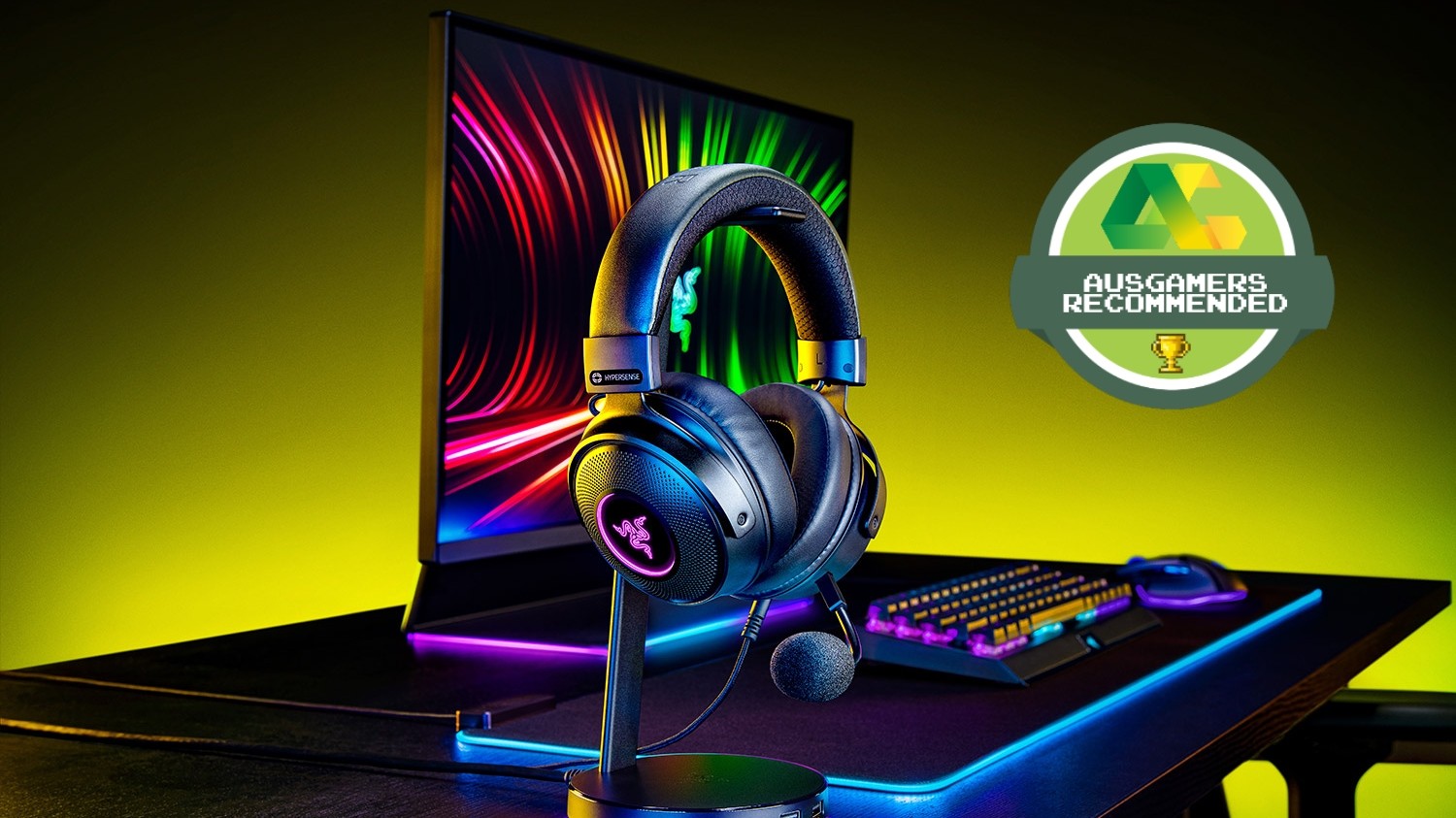Razer Kraken V3 Hypersense Gaming Headset Review
Review By KostaAndreadis @ 05:53pm 10/03/22

Product: Razer Kraken V3 Hypersense Wired USB Gaming Headset
Type: Gaming Headset (Wired)
Price: $224.95 AUD
Availability: Out Now
Link: razer.com/au-en/gaming-audio/razer-kraken-v3-hypersense
Haptic technology in a gaming headset is pretty rare, so much so that it’s the first thing you notice when looking at the Razer Kraken V3 Hypersense packaging, when you’re opening it up, and then when you’re firing up your first game or bit of media content. Essentially it’s head rumble that vibrates and does a little rattle whenever there’s bass in a mix. Of course, there’s a lot more to it than that and there’s a lot more tech involved than sticky-taping a pair of N64 Rumble Paks to the left and right ear cups.
For Razer the addition of haptics is a step towards “true multi-sensory gaming”, via driver integration, positioning, and intensity of the tech. And you can understand the reasoning for its inclusion, especially when Sony is looking to add haptic tech to the upcoming PlayStation VR2 headset – it’s all about that immersion.
Throw in Razer Kraken V3 Hypersense’s THX Spatial Audio surround and the desired effect was felt almost immediately upon firing up the cyberpunk action of Ghostrunner on PC. In an early sequence not only could I hear the rumble of a flying vehicle overhead but the haptic feedback was such that its presence was felt. The effect was specific to the vehicle, and the contrast between that and other ambient sound effects was immersive to say the least.
But, to be completely honest, Hypersense is something you would use sparingly. Fine for games but pretty bad for music and video watching. Thankfully, underneath the somewhat superfluous rumble tech lies a Razer gaming headset with impressive audio and a premium feel.
Tech Talk

Okay so setting aside Hypersense haptic feedback, Razer’s TriForce Titanium drivers - which separate the high, mid, and low frequencies - you've got a very warm and overall mostly balanced sound. Very cool. For music this means no overtly menacing game-style bass, a clear mid-range, and highs that aren’t over-the-top in the crisp department.
Throw in Razer Kraken V3 Hypersense’s THX Spatial Audio surround and the desired effect was felt almost immediately upon firing up the cyberpunk action of Ghostrunner on PC.
As a wired designed-for-PC USB headset, configuration and customisation, is handled by Razer Synapse software where you can adjust the intensity of Hypersense (or disable it), mess around with various equaliser settings, and check out the different THX Spatial Audio modes. For media and music the best option is to turn off Hypersense and THX surround because of how great the overall out-of-the-box sound is.
The haptic rumblings and vibration of Hypersense serve to negatively affect music in a way that reminds me of being in a small car with a subwoofer rattling anything and everything. It’s not so much the amplification of bass but that the vibration seemingly sacrifices stereo width and detail, making everything sound small and super close to your ears.
Headphone:
- Drivers: 50mm (Razer TriForce Titanium)
- Frequency response: 20 Hz - 20 kHz
- Surround: THX Spatial Audio
- Microphone type: Detachable HyperClear Cardioid (Unidirectional)
- Microphone Frequency response: 100 Hz – 10 kHz
- Headset controls: Volume, Mic mute toggle, Haptics Adjuster, Razer Chroma RGB cycle
- Weight: 344 grams
- Cable length: 2m (USB-A)
As a wired USB gaming headset, versatility is limited, but Razer has packed in quite a bit in terms of audio tech to make it a great option for all-things audio on the desktop or laptop front. The drivers here are not only powerful, but the detachable unidirectional microphone makes it for great voice chat. And it’s only on PC where you’ve got access to THX Spatial Audio, which definitely adds directional depth to a number of games. It’s still virtual surround, so it is limited, but it plays a lot nicer with Hypersense than music or watching videos.
Design and Comfort

Although you could chalk up the high price-tag (for a wired PC headset) to the inclusion of Hypersense, it sits alongside build quality that is uniformly excellent. From the steel-reinforced headband to the comfy cushions to the grating and RGB-powered Razer logo, the Razer Kraken V3 Hypersense has the feel and physical qualities of a premium bit of audio. Even the volume wheel is great. And the braided USB cable too, though it’s not detachable.
As a wired USB gaming headset, versatility is limited, but Razer has packed in quite a bit in terms of audio tech to make it a great option for all-things audio on the desktop or laptop front.
The headset also includes on-board controls for Hypersense and RGB modes so you can make adjustments without having to fire up software. Weighing in at 344 grams it also sits comfortably, without causing too much strain even after extended use. And with all of the vibration that comes from Hypersense, the fit is snug and stable enough where I didn’t really notice the cups themselves moving or having to make adjustments based on the bass shifting things around.
Sounds Like

Razer TriForce Titanium audio drivers and the excellent build quality make the Razer Kraken V3 Hypersense a great option for a wide range of audio inputs. But, at its core this is clearly a gaming headset designed for exactly that - gaming. Plus being USB does mean a big part of its extended features are limited to PC gaming. Haptics might muddle and affect music in a way that’s detrimental, but it does have the opposite effect when playing certain games. From the aforementioned Ghostrunner, to God of War to Dying Light 2 Stay Human to even a bit of Cyberpunk 2077 (thanks to the recent Patch 1.5 release).
At its core this is clearly a gaming headset designed for exactly that - gaming. Plus being USB does mean a big part of its extended features are limited to PC gaming.
As audio-driver based tech, in that there’s no real software to back it up, the quality of the haptics does vary. Playing on the High setting is usually a no-go on account of just how overbearing it becomes, but on Low and games that use bass and lower frequencies sparingly it definitely ramps up immersion. There’s nothing quite like feeling that “you’re in it” and right there in a digital world, and when Hypersense is delivering on that promise the effect is impressive.
In the end though it’s a nice to have but not essential. And thankfully the relatively pricey for a wired headset Razer Kraken V3 Hypersense has got it where it counts. Great audio, a comfortable fit, and excellent build quality.
|
What we liked
Great sound from Razer’s audio drivers
Comfortable and sturdy build quality
Premium look and feel
THX Spacial Audio is a good virtual surround option
Hypersense haptic feedback works well in certain situations
|
What we didn't like
USB means it’s pretty much limited to PC to get the most out of it
Razer Synapse software not always stable
Hypersense haptic feedback is detrimental to music and hit-and-miss with games
|
We gave it:
8.0
OUT OF 10
|
Latest Comments


















